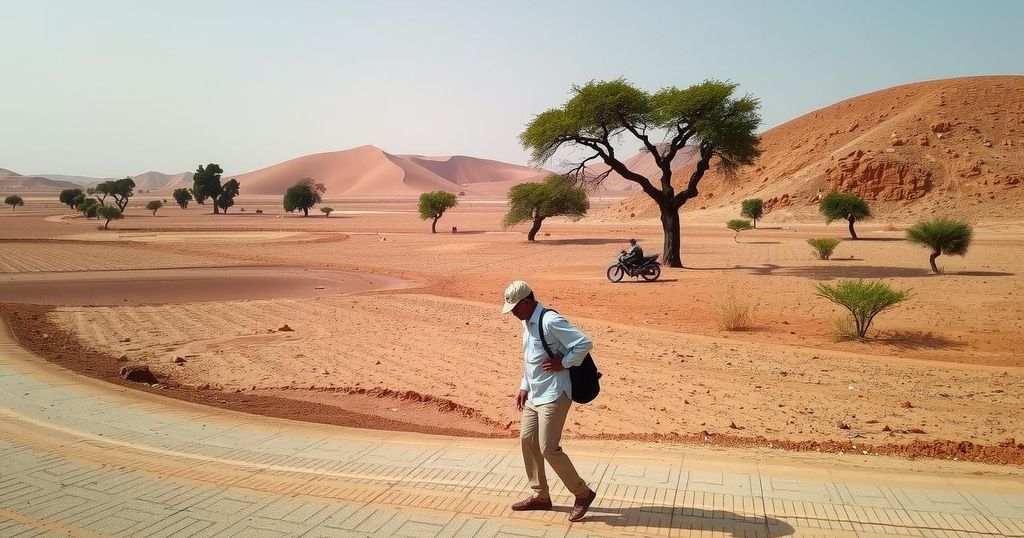The Sahel is facing severe flooding due to climate change, displacing millions and crippling agriculture. Political instability from coups in Burkina Faso, Mali, and Niger has affected governance and stifled access to international climate finance. Organizations like OSS promote community-led adaptation initiatives, yet the combined challenges of weak governance and reduced funding complicate effective climate resilience. Sustainable strategies and regional cooperation are vital for addressing these pressing challenges and ensuring long-term resilience in the Sahel.
The Sahel region, encompassing countries like Burkina Faso, Mali, Niger, Chad, Nigeria, and Sudan, is grappling with severe climate change effects, particularly flooding during the rainy season from July to September. This year, torrential rains led to significant flooding, displacing millions and devastating agriculture. Concurrent military coups have further complicated the situation, disrupting governance and climate adaptation initiatives while restricting access to international climate financing due to political isolation from Western nations.
Organizations such as the Sahara and Sahel Observatory (OSS) advocate for empowering local communities to enhance climate resilience through initiatives focused on sustainable management of land and water resources. However, political instability and weak governance hinder progress, despite the region’s potential for utilizing renewable energy and sustainable agricultural practices.
In Mali, the catastrophic overflow of the Niger River, exacerbated by the heaviest rainfall in over fifty years, serves as a tragic reminder of the Sahel’s vulnerabilities. The European Union has provided some aid, but the overall disruption to governance due to military rule in Mali, Niger, and Burkina Faso complicates climate responsiveness and diminishes international support.
As one of the world’s most vulnerable regions to climate change, the Sahel faces increased droughts and flooding that threaten the livelihoods of millions, primarily reliant on subsistence farming. Experts emphasize that military governments prioritize security over environmental policies, leading to fragmented climate adaptation initiatives and disrupting international projects.
Countries such as Chad and Mauritania, with slightly more stable governance, are integrating climate adaptation into national development strategies, though often driven by security considerations at the cost of long-term resilience. Sanctions from the West further exacerbate funding shortages in military-ruled countries, making it challenging to secure resources for adaptation projects.
Despite financial constraints, some local governments are reallocating budgets to address essential climate adaptation needs, while regional organizations like OSS strive to aid these governments in accessing international climate funds. However, significant hurdles remain due to the lack of institutional capacity to navigate the complex climate finance landscape.
Community-based adaptation strategies, such as the establishment of Water User Associations, are crucial for effective resilience in the Sahel. These efforts promote sustainable resource management through collective action, enabling local communities to address water scarcity challenges effectively.
Experts argue that regional cooperation and strengthened governance frameworks are pivotal for addressing the intertwined challenges of political instability and climate change. While military-led governance poses significant obstacles, this crisis cannot wait for political stability. Sahelian countries must focus on local, community-driven adaptation strategies while seeking partnerships and support from the international community.
Furthermore, potential renewable energy projects, such as the interconnection of the West African Power Pool, could facilitate cleaner energy access, supporting long-term resilience goals. Overall, despite facing substantial challenges, a collaborative approach that combines local knowledge with informed governance frameworks could pave the way for a more sustainable Sahel.
The Sahel region, located south of the Sahara Desert, is highly vulnerable to climate change due to its semiarid climate and dependency on agriculture. The reliance on subsistence farming places millions at risk as prolonged droughts and unpredictable weather patterns disrupt livelihoods. The situation is exacerbated by political instability caused by military coups in vital nations like Burkina Faso, Mali, and Niger, which not only hampers governance structures but also limits access to international climate financing and support. Consequently, communities struggle to cope with ongoing environmental crises, necessitating innovative and localized adaptation strategies to build resilience against climate impacts. Organizations like the Sahara and Sahel Observatory aim to facilitate community-led initiatives, emphasizing the importance of local knowledge and practices in adaptation efforts. However, significant challenges stemming from political isolation and funding gaps continue to impede effective climate responses in the region.
In conclusion, the Sahel region is at a critical junction, facing the dual challenges of political instability and severe climate impacts. While local communities are taking initiative towards adaptation, the broader environment of military governance and international isolation limits their potential for sustainable progress. Community-based strategies, aided by organizations like OSS, hold promise for building resilience, but strong governance and regional cooperation remain essential for addressing the comprehensive challenges posed by climate change. Only through collaborative efforts—balancing security and environmental priorities—can the Sahel hope to forge a resilient path forward.
Original Source: news.mongabay.com






